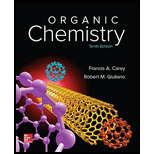
ORGANIC CHEMISTRY-W/ACCESS >CUSTOM<
10th Edition
ISBN: 9781260028362
Author: Carey
Publisher: MCG CUSTOM
expand_more
expand_more
format_list_bulleted
Question
Chapter 14.15, Problem 19P
Interpretation Introduction
Interpretation:
Whether the carbonyl carbon of an
Concept introduction:
The electron donating groups increase electron density around the proton and shield (protect) the nucleus from applied magnetic field; this is called shielding.
The carbonyl carbon is deshielded because it is doubly bonded to electronegative oxygen atom.
Expert Solution & Answer
Want to see the full answer?
Check out a sample textbook solution
Students have asked these similar questions
In a few sentences, briefly explain the difference between acid catalyzed and base promoted enolation of aldehydes and ketones.
Explain using resonance structures of the intermediates (please explain and draw them out) why the bromination of phenol is faster than the bromination of phenyl ester?
Draw the structure(s) resulting from the movement of the electrons.
In the reaction above, why would the hydroxide, OH-, be attracted to the carbon on the carbonyl as opposed to the other carbons on the same molecule?
Chapter 14 Solutions
ORGANIC CHEMISTRY-W/ACCESS >CUSTOM<
Ch. 14.3 - Prob. 1PCh. 14.3 - Prob. 2PCh. 14.4 - The 1H NMR signal for bromoform (CHBr3) appears at...Ch. 14.5 - identify the most shielded and least shielded...Ch. 14.5 - (a) Assign the chemical shifts 1.6, 2.2, and 4.8...Ch. 14.5 - Assign the chemical shifts 1.1, 1.7, 2.0, and 2.3...Ch. 14.5 - Assign the chemical shifts 1.6, 4.0, 7.5, 8.2, and...Ch. 14.6 - The 300-MHz 1H NMR spectrum of 1,4-dimethylbenzene...Ch. 14.6 - Prob. 9PCh. 14.6 - How many signals would you expect to find in the...
Ch. 14.7 - Describe the appearance of the 1H NMR spectrum of...Ch. 14.8 - Describe the appearance of the 1H NMR spectrum of...Ch. 14.11 - Prob. 13PCh. 14.11 - Prob. 14PCh. 14.12 - Hydrogen bonding between the oxygen of dimethyl...Ch. 14.14 - Prob. 16PCh. 14.15 - The 13C NMR spectrum of 1-bromo-3-chloropropane...Ch. 14.15 - Consider carbons x, y, and z in p-methylanisole....Ch. 14.15 - Prob. 19PCh. 14.16 - To which of the compounds of Problem 14.16 does...Ch. 14.18 - DEPT spectra for a compound with the formula...Ch. 14.20 - Vibrational frequencies are sensitive to isotopic...Ch. 14.21 - Prob. 23PCh. 14.22 - Prob. 24PCh. 14.23 - Prob. 25PCh. 14.23 - Which one of the C5H8 isomers shown has its max at...Ch. 14.24 - Knowing what to look for with respect to isotopic...Ch. 14.24 - The base peak appears at m/z105 for one of the...Ch. 14.24 - Mass spectra of 1-bromo-4-propylbenzene and...Ch. 14.25 - Prob. 30PCh. 14 - Each of the following compounds is characterized...Ch. 14 - Deduce the structure of each of the following...Ch. 14 - From among the isomeric compounds of molecular...Ch. 14 - The H1NMR spectrum of fluorene has signals at 3.8...Ch. 14 - Prob. 35PCh. 14 - H1NMR spectra of four isomeric alcohols with...Ch. 14 - Prob. 37PCh. 14 - We noted in Section 14.13 that an NMR spectrum is...Ch. 14 - Identify each of the C4H10O isomers on the basis...Ch. 14 - A compound (C3H7ClO2) exhibited three peaks in its...Ch. 14 - Label nonequivalent carbons in the following...Ch. 14 - Compounds A and B are isomers of molecular formula...Ch. 14 - C13 NMR spectra for four isomeric alkyl bromides...Ch. 14 - Prob. 44PCh. 14 - Prob. 45PCh. 14 - Identify the C3H5Br isomers on the basis of the...Ch. 14 - Prob. 47PCh. 14 - A compound (C8H10O) has the IR and H1NMR spectra...Ch. 14 - Deduce the structure of a compound having the...Ch. 14 - Figure 14.53 presents IR, H1NMR, C13NMR and mass...Ch. 14 - H1NMR, C13NMR, IR, and mass spectra are shown for...Ch. 14 - 1H NMR and IR spectra for a compound with the...Ch. 14 - FriedelCraftsalkylation of benzene with...Ch. 14 - Prob. 54DSPCh. 14 - Prob. 55DSPCh. 14 - Prob. 56DSPCh. 14 - Prob. 57DSPCh. 14 - Prob. 58DSP
Knowledge Booster
Similar questions
- The reaction that occurs when the benzaldehyde you have is reacted in a basic environment is called the Cannizzaro reaction, and when it is reacted with cyanide, it is called benzoin. It Explain the reason by writing the reaction mechanisms of the reactions.arrow_forwardWhy do you think the product undergoes favorable dehydration?arrow_forwardWhy would you expect 2-bromoethanol to decompose to a gluey product over time?arrow_forward
- What alkenes would give only an aldehyde with four carbons as a product of oxidative cleavage?arrow_forwardExplain why the acid-catalyzed dehydration of an alcohol is a reversible reaction, whereas the base-promoted dehydrohalogenation of an alkyl halide is an irreversible reaction.arrow_forwardWhat is the major product from the reaction of neopentyl bromide with warm ethanol?arrow_forward
- What would be the products for the 2-Methylcyclopentanethiol dehydration reaction be?arrow_forward) Draw the NMR spectrum you would expect from the corresponding aldehyde whose oxidation gives this carboxylic acid.arrow_forward) Specifically, what is the difference between the cyclopentadienyl anion and pyrrole?arrow_forward
- How do you account for the fact that the dipole moment of acetonitrile is considerably greater than that of either fluoromethane or chloromethane?arrow_forwardWhat alkene would give only a ketone with three carbons as a product of oxidative cleavage?arrow_forwardWhat are the aldehydes that give the cannizzaro reaction? What are the reaction examples?arrow_forward
arrow_back_ios
SEE MORE QUESTIONS
arrow_forward_ios
Recommended textbooks for you
 Macroscale and Microscale Organic ExperimentsChemistryISBN:9781305577190Author:Kenneth L. Williamson, Katherine M. MastersPublisher:Brooks Cole
Macroscale and Microscale Organic ExperimentsChemistryISBN:9781305577190Author:Kenneth L. Williamson, Katherine M. MastersPublisher:Brooks Cole

Macroscale and Microscale Organic Experiments
Chemistry
ISBN:9781305577190
Author:Kenneth L. Williamson, Katherine M. Masters
Publisher:Brooks Cole